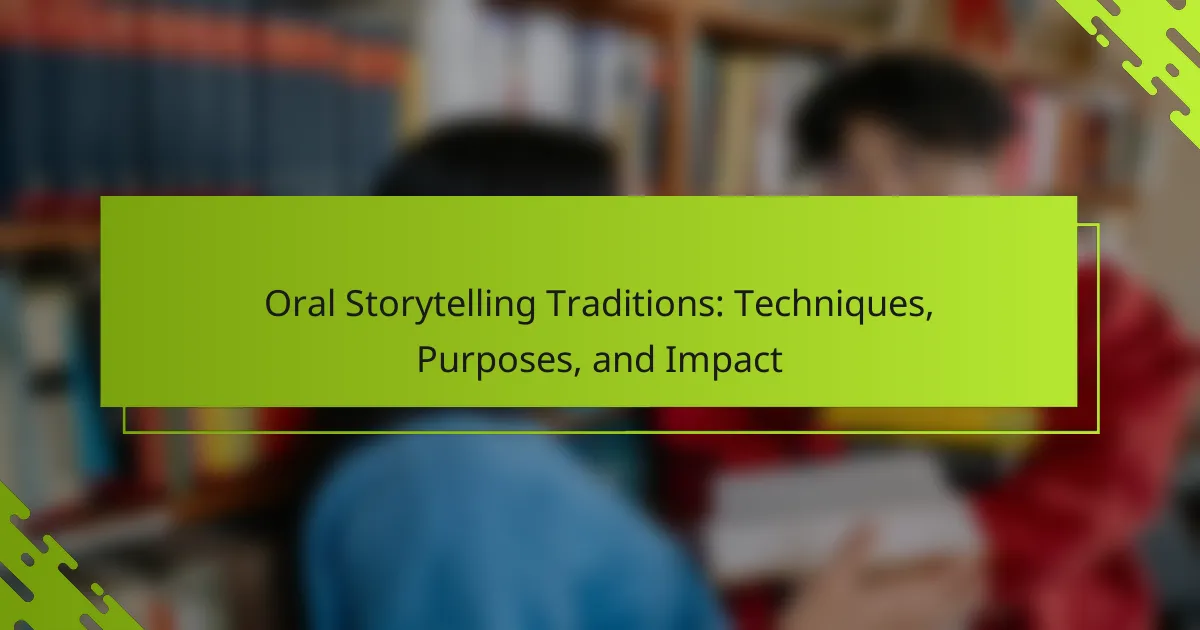Oral storytelling traditions play a crucial role in preserving culture and fostering community bonds. This article explores key techniques like rhythm and audience interaction, highlights their purposes such as education and cultural preservation, and examines the significant impact on social cohesion. Additionally, it delves into unique and rare attributes that differentiate various storytelling traditions across cultures.

What are the key characteristics of oral storytelling traditions?
Oral storytelling traditions are characterized by their use of narrative techniques, cultural purposes, and significant impact on communities. Key techniques include the use of rhythm, repetition, and audience interaction, which enhance engagement. The purposes often involve preserving history, teaching morals, and fostering community identity. The impact includes strengthening social bonds and passing down cultural heritage through generations.
How do cultural contexts influence storytelling techniques?
Cultural contexts significantly shape storytelling techniques by influencing themes, narrative structures, and audience engagement. For instance, in many Indigenous cultures, oral storytelling serves to preserve history and impart moral lessons. This contrasts with Western traditions, which often prioritize entertainment and individualism. Additionally, cultural values dictate the use of metaphors, symbolism, and character archetypes, enriching the storytelling experience. As a result, the impact of cultural contexts on storytelling is profound, affecting both the content and the way stories resonate with audiences.
What role does audience engagement play in oral storytelling?
Audience engagement is crucial in oral storytelling as it enhances connection and retention. Engaged listeners are more likely to internalize the narrative, leading to a deeper understanding of the story’s themes. Techniques such as eye contact, vocal variation, and interactive elements stimulate participation and emotional investment. This interaction fosters a shared experience, making the storytelling impactful and memorable. Engaged audiences often contribute feedback, enriching the storytelling tradition and allowing for adaptation and evolution over time.

What techniques are commonly used in oral storytelling?
Common techniques in oral storytelling include vivid imagery, repetition, audience interaction, and the use of rhythm. These methods enhance engagement and retention. Vivid imagery creates mental pictures, while repetition reinforces key themes. Audience interaction invites participation, making stories more memorable. Rhythm adds a musical quality, enhancing the storytelling experience.
How do narrative structures differ across cultures?
Narrative structures vary significantly across cultures, reflecting unique storytelling techniques and purposes. Cultural context influences themes, character development, and moral lessons. For example, Western narratives often emphasize individualism, while many Indigenous stories highlight community and interconnectedness. Additionally, oral storytelling traditions utilize distinct techniques such as repetition and call-and-response, enhancing engagement and memory retention. These differences impact how stories are perceived and their overall significance within each culture.
Which performance styles enhance storytelling effectiveness?
Dynamic performance styles, such as physicality, vocal variation, and audience interaction, significantly enhance storytelling effectiveness. These techniques engage listeners, create emotional connections, and facilitate immersion in the narrative.
Physicality involves using body language and movement to convey emotions and actions, making stories more vivid. Vocal variation includes modulating pitch, tone, and pace to maintain interest and highlight key moments. Audience interaction fosters a participatory atmosphere, allowing listeners to feel involved and invested in the story.
Incorporating these performance styles can lead to a memorable storytelling experience, emphasizing the impact of oral traditions in preserving cultural narratives.
What are the roles of rhythm and repetition in storytelling?
Rhythm and repetition enhance oral storytelling by creating a memorable experience and reinforcing themes. Rhythm establishes a flow that captivates listeners, while repetition emphasizes key ideas, making them resonate. These techniques foster engagement and aid retention, allowing stories to be passed down through generations effectively.

What purposes do oral storytelling traditions serve?
Oral storytelling traditions serve multiple purposes, including cultural preservation, education, and community bonding. They transmit history, values, and morals across generations, enhancing social cohesion. Storytelling techniques, such as repetition and dramatization, engage audiences and foster imagination. Such traditions also provide entertainment and a sense of identity, reinforcing cultural heritage.
How do stories convey cultural values and morals?
Stories convey cultural values and morals through oral storytelling traditions that reflect community beliefs. These narratives often feature relatable characters and situations, illustrating ethical dilemmas and societal norms. By engaging listeners, storytellers reinforce shared values and encourage reflection on personal and collective experiences. Oral traditions adapt over time, incorporating contemporary issues while preserving foundational morals, ensuring relevance across generations.
In what ways do oral traditions preserve history and knowledge?
Oral traditions preserve history and knowledge through storytelling techniques that emphasize memory, community, and cultural identity. These narratives are passed down through generations, ensuring the continuity of cultural values and historical events. Storytelling techniques, such as repetition and rhythm, enhance memorization and engagement. As a result, oral traditions serve as a vital means of transmitting wisdom, moral lessons, and communal histories. This preservation fosters a sense of belonging and identity among community members.
How do stories foster community and social bonds?
Stories foster community and social bonds by creating shared experiences and fostering empathy. Oral storytelling traditions utilize techniques such as narrative structure, character development, and cultural references to engage audiences. These stories serve various purposes, including preserving history, teaching morals, and strengthening group identity. The impact of storytelling can be profound, as it enhances social cohesion and facilitates communication among diverse groups, reinforcing a sense of belonging.

What impact do oral storytelling traditions have on society?
Oral storytelling traditions significantly impact society by preserving culture, fostering community bonds, and enhancing communication skills. They transmit values, history, and identity across generations, creating a shared sense of belonging. For instance, storytelling strengthens interpersonal connections, promoting empathy and understanding among diverse groups. Additionally, these traditions often adapt to modern contexts, ensuring relevance and engagement. As a result, oral storytelling remains a vital tool for education and cultural continuity.
How do they influence identity formation within communities?
Oral storytelling traditions significantly influence identity formation within communities by preserving cultural heritage. These narratives convey shared values, beliefs, and historical experiences, fostering a sense of belonging. Through storytelling techniques, such as repetition and vivid imagery, communities reinforce their collective identity. Additionally, storytelling serves as a platform for intergenerational communication, allowing younger members to connect with their roots and understand their place within the community. This process of shared narratives strengthens social bonds and enhances cultural continuity.
What role do they play in education and learning?
Oral storytelling traditions play a vital role in education and learning by enhancing cultural transmission and critical thinking. These traditions foster engagement, allowing learners to connect emotionally with content. Storytelling techniques, such as narrative structure and character development, aid memory retention and comprehension. As a result, oral storytelling serves as an effective pedagogical tool, promoting creativity and collaboration among learners.
How are oral storytelling traditions adapting in the digital age?
Oral storytelling traditions are adapting to the digital age by integrating multimedia elements and online platforms. Storytellers now use video, podcasts, and social media to reach broader audiences. This evolution allows for interactive engagement, enhancing the storytelling experience. Additionally, digital archives preserve traditional narratives, ensuring cultural heritage remains accessible.

Which unique attributes distinguish specific oral storytelling traditions?
Unique attributes that distinguish specific oral storytelling traditions include cultural context, narrative structure, and performance style. Each tradition reflects its community’s values and history, shaping the storytelling approach. For example, African oral traditions often emphasize communal participation, while Native American storytelling may incorporate spiritual elements and nature. Additionally, the use of language, such as dialects or metaphors, can vary significantly, enhancing the uniqueness of each tradition. These attributes contribute to the preservation of cultural identity and collective memory across generations.
What are some notable regional variations in storytelling methods?
Oral storytelling traditions exhibit notable regional variations in techniques, purposes, and impacts. For instance, Indigenous cultures often use storytelling to preserve history and teach morals, while African storytelling incorporates music and dance for communal engagement. In contrast, East Asian traditions may focus on philosophical lessons, utilizing a more structured narrative form. Each region’s unique attributes shape the storytelling experience, influencing both the content and the audience’s connection to the tales.
How do individual storytellers develop unique styles?
Individual storytellers develop unique styles through personal experiences, cultural influences, and distinct techniques. These factors shape their narratives and delivery methods.
Storytellers often draw from their backgrounds, incorporating local traditions and values into their stories. For instance, a storyteller from a coastal region may emphasize maritime themes, while one from a mountainous area might focus on nature and adventure.
Techniques such as voice modulation, pacing, and body language also play a crucial role in defining a storyteller’s style. A storyteller who uses dramatic pauses can create suspense, while another who employs humor may engage the audience differently.
Moreover, the impact of audience interaction can lead to the evolution of a storyteller’s style. Adapting stories based on audience reactions fosters a unique connection and refines the storytelling approach over time.

What are some rare attributes found in oral storytelling traditions?
Rare attributes in oral storytelling traditions include unique narrative structures, specific cultural motifs, and distinct performance styles. These elements often vary significantly between cultures, showcasing the diversity of storytelling. For example, some traditions utilize call-and-response techniques, while others may incorporate elaborate gestures or musical elements. Such attributes enrich the storytelling experience and reflect the values of the community. Additionally, the use of local dialects or languages can create a sense of identity and belonging among listeners.
How do specific storytelling practices emerge in isolated communities?
Specific storytelling practices in isolated communities emerge from cultural heritage, social cohesion, and environmental influences. These communities often develop unique oral traditions that reflect their values and experiences.
Techniques such as call-and-response, repetition, and metaphor are common, enhancing engagement and retention. The purpose of these practices includes preserving history, teaching morals, and fostering community identity.
The impact of oral storytelling can be profound, shaping social norms and reinforcing collective memory. These traditions adapt over time, influenced by external interactions while maintaining core elements that define the community’s narrative style.
What unusual themes or motifs appear in lesser-known traditions?
Lesser-known oral storytelling traditions often feature unusual themes such as nature’s personification, ancestral spirits, and community identity. These motifs serve unique purposes, like preserving cultural heritage and fostering communal bonds. For instance, some traditions use animal characters to convey moral lessons, while others explore the interplay between the natural and supernatural worlds. Such themes can reveal insights into values and beliefs that differ significantly from mainstream narratives.

How can one effectively learn and practice oral storytelling?
To effectively learn and practice oral storytelling, engage in active listening and practice regularly. Immerse yourself in diverse storytelling traditions to understand techniques and purposes.
Start by identifying a story that resonates with you. Break it down into key elements: characters, setting, conflict, and resolution. Focus on the emotional arc and pacing. Practice storytelling aloud, emphasizing vocal variety and body language to enhance engagement.
Seek feedback from peers or mentors to refine your delivery. Participate in storytelling events or workshops to gain experience and confidence. Embrace the unique aspects of your voice and style, as these contribute to your storytelling impact.
What are the best practices for developing storytelling skills?
To develop storytelling skills effectively, focus on practice, observation, and feedback. Engage in storytelling regularly to build confidence and technique. Analyze different styles of oral storytelling traditions to understand their techniques and purposes. Seek constructive criticism from peers to refine your approach. Emphasize emotional connection to enhance audience engagement.
Which common mistakes should aspiring storytellers avoid?
Aspiring storytellers should avoid common mistakes like lack of clarity, excessive detail, ignoring audience engagement, and failing to practice. Clarity ensures the story is understood. Excessive detail can distract from the main narrative. Engaging the audience keeps their interest. Regular practice hones storytelling skills.
How can storytelling be integrated into modern communication?
Storytelling can enhance modern communication by making messages more relatable and memorable. Oral storytelling traditions utilize techniques like vivid imagery and emotional engagement to connect with audiences. These methods foster understanding and retention, making complex ideas accessible. Additionally, storytelling serves various purposes, such as cultural preservation and community bonding, which remain relevant in today’s digital landscape. The impact of storytelling is profound, as it shapes perceptions and influences behavior across diverse platforms.
